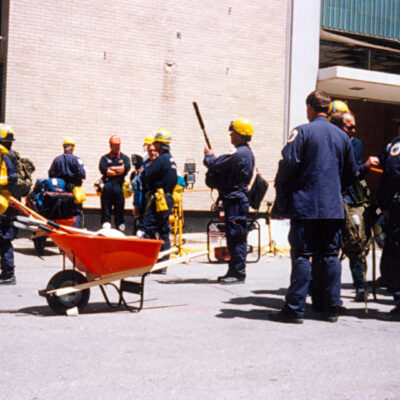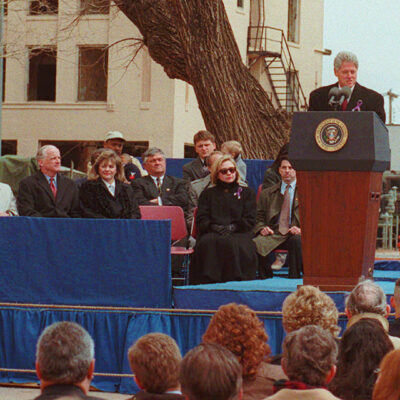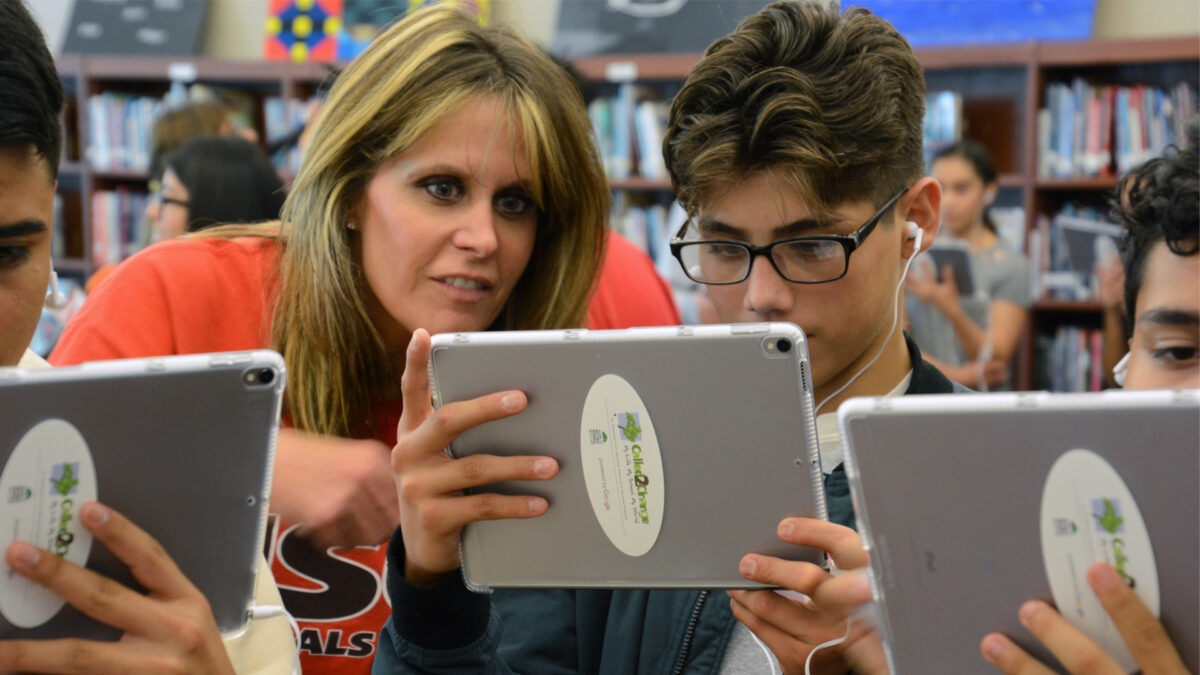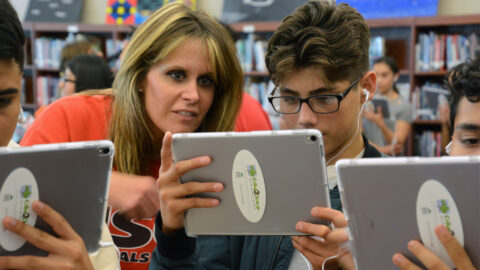Lesson Plan
How Do We Change the World?
Being an Oklahoman means that even during the worst disasters possible, we stand strong and not only survive, but thrive. The Oklahoma Standard means we are responsible for helping our neighbors and acting in kindness, without hesitation or expecting anything in return. In this state, we honor victims and serve those in need of comfort and support.
Many tornadoes, fires, and winter storms have given Oklahomans the opportunity to lift each other up during difficult times; however, no time period has been more difficult than April 19, 1995. Oklahomans learned how to unite during one of the worst time periods of our state’s history, and the worst act of domestic terror in American history.
The Oklahoma City bombing was an attack on America’s Heartland. One of the most commonly used words to describe the people of Oklahoma during this time was resilient. A great deal was lost that day; however, what wasn’t lost was our will to survive. Oklahoma proved to be not only America’s Heartland, but the people of Oklahoma brought light to this dark day through our actions of love, care, and support; creating and giving life to the Oklahoma Standard.
Lesson Summary
In this lesson, students will analyze the efforts of everyday citizens in the state of Oklahoma in the aftermath of the Alfred P. Murrah Federal Building bombing.
- Essential Questions: How do we change the world?
- Time frame: 2 class periods
- Subject(s): Social Studies
Materials Needed
- Pencil
- Notebook Paper
- Colored Pencils
- Markers
- Poster Paper (used with Color, Symbol, Image)
- Sticky Notepads (Used with Commit and Toss)
- Blank Frayer Model
- Frayer Model OKC example (Teachers use this as the model for Frayer Model)
Teacher Tip: Make more than one copy of anything you model so kids can pass it around and get a closer look. This allows visual and kinesthetic students to pay more attention to the model.
Lesson
Students will examine the words service, honor and kindness using the commit and toss strategy.
- Commit and Toss: Each student will receive a sticky note on their desk.
- The teacher will present the students with a question. Which of the following character traits is most needed when trying to change the world: service, honor or kindness?
- Students will turn and talk to a neighbor and discuss their answer.
- Students will then discuss aloud and the teacher will take a classroom vote.
- After this vote, the teacher will ask students to write down on the sticky note one act of honor, service or kindness they could carry out in their own neighborhoods. Encourage students to be appropriate in their responses prior to writing down their answers.
- Students will ball up their sticky notes and then lightly throw them about the room. Teachers may have students throw the notes more than once in order to mix up the answers.
- Students will then pick up the sticky notes and read each answer aloud.
Students will use the Frayer Model to define the Oklahoma Standard.
- Students separate a page into four quadrants by drawing one horizontal line and one vertical line (essentially drawing a full-page plus sign) with an oval in the center.
- They label quadrants as follows (beginning from the upper-left quadrant moving clockwise): definition, characteristics, examples, non-examples.
- Students will write “Oklahoma Standard” in the center oval of the graphic organizer.
- Use the example provided to explain how to complete the Frayer Model. Be sure to give students ample time to complete the assignment.
- Allow students to share their ideas with a partner and change their models as they gain new perspectives.
- Partners/small groups can then share their thoughts or participate in a whole-class discussion (optional).
Students will use the Color, Symbol and Image (CSI) method to create a poster over the Oklahoma Standard.
- Students write down what they already know about the Oklahoma Standard.
- Second, students will then individually read the article “Resilience: 20 years later. Oklahoma Standard continues with new campaign.” http://newsok.com/article/5406282
- Next, independently or in small groups, students then select a color, create a symbol and draw an image on poster paper that represents the Oklahoma Standard.
- Students should be able to justify their choices.
- Once their colors, symbols, and images are complete, students can share their CSI boards with the rest of the class (optional).
Students will relate the Oklahoma Standard to their own educational and personal goals.
Wall of Reasons Assignment
Step 1
- Teacher’s special note: Share your motivation on why you finished high school and what made the moment so special.
- Include your biggest obstacles, doubters and what made you want to come back and help others succeed.
- After your talk, write down your motivation for teaching students on a large, colored sticky-note, and post it on the wall.
- Explain how this relates to your act of service for the Oklahoma Standard.
Step 2
- Hand out large sticky notes to each student and have them write one reason they want to succeed in high school and one way they can serve other students in the classroom.
- Students do not have to read these aloud and should not put their names on them. Instead, have them write a “motivation phrase.” This will be put in the corner of the paper and should only be known by the student. It could be a subject, the name of a favorite family member, a favorite number or even the name of their biggest doubter.
- The students will then place their notes on a wall in the class.
- This is important for students to visualize each other’s goals and create ideas for how to help each other succeed and creates a supportive element for the classroom called the “Wall of Reasons.”
- Students can revisit this wall in the classroom in moments of struggle to help them refocus their efforts on their own education and servicing others.
Teacher Tip: If a student says they don’t know why they are here, this is okay because these are the most important students to focus on during this activity. Any student with difficulty may need some realignment in their focus. Ask questions about their brothers and sisters, let them know the more education they receive, the better chance their siblings will follow. Also, talk about how education has helped changed this country through various movements.
Students will participate in a challenge which makes them accountable for carrying out an act of service, honor or kindness.
- #STANDINGISOK – Students will provide a value beyond school by encouraging each other to participate in the STANDINGISOK Challenge. This is a social challenge in which students look to change the climate in their school.
- First, students will write on a small colorful strip of paper, a promise they will fulfill to serve their school, honor someone in their lives or participate in an act of kindness for a member of their school.
- This strip will be posted in a visible area of the school, only AFTER the promise has been fulfilled.
- The promise strip can only be posted by the person affected by the promise. For example, if a student brings a bag of candy to school and gives it as a gift to the new student in class, then the new student must take the promise strip and post it in a visible area in the school.
- The person affected by the acts of the Oklahoma Standard, then must create a promise strip themselves, and carry out an act for the next person of their choice.
- This assignment is built to encourage young people that being positive and standing up for what is right is OK! Students may use the #STANDINGISOK as a promotional tool on social media to widen their influence on the community.
Oklahoma History 5.10 Cite specific textual and visual evidence to analyze the causes and effects of the domestic terrorist attack on the Murrah Federal Building in Oklahoma City including the responses of Oklahomans to the event, the concept of the Oklahoma Standard and the creation of the Oklahoma City National Memorial & Museum.
NCSS Standard D2.Civ.2.K-2. Explain how all people, not just official leaders, play important roles in a community.
Color, Symbol, Image (CSI) – Keeley, P. (2015). Science formative assessment: 50 more strategies for linking assessment, instruction, and learning. Thousand Oaks, CA: Corwin, SAGE.
Frayer Model – Keeley, P. (2008). Science formative assessment: 75 practical strategies for linking assessment, instruction, and learning. Thousand Oaks, CA: Corwin, SAGE.





